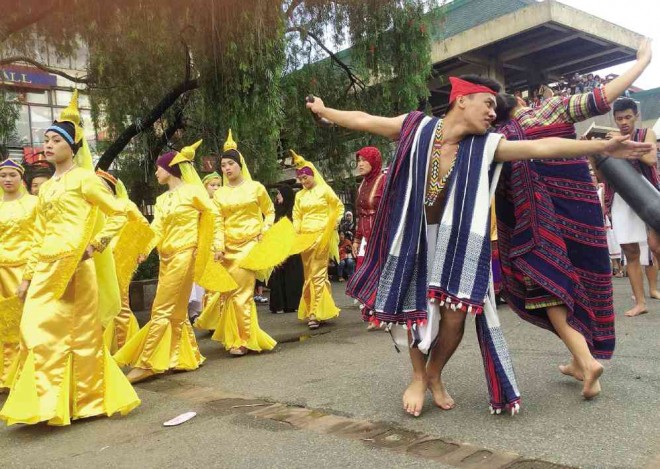Cordillera, Maranao folk unite in ethnic day fest

MARANAO dancers (left) and their refined dance steps meld with the frantic dance steps of Cordillera youths at Igorot Park in Baguio City, where the city’s indigenous Filipinos celebrated Tribal Filipino Sunday (now Indigenous Peoples’ Sunday) with the second Gong Festival. VINCENT CABREZA/ INQUIRER NORTHERN LUZON
BAGUIO CITY—Cordillera folk in G-strings and the Maranao in gold-hued garments united for the second Gong Festival here on Sunday amid efforts to document rules that would preserve the best values of these indigenous and migrant peoples in the upland region.
The youth and the elderly from Benguet, Ifugao, Kalinga, Mt. Province and Abra provinces, and the newly formed organization representing over 12,000 migrants from Mindanao performed dances along the sidewalks of downtown Baguio City before proceeding to Burnham Park during the festival that coincided with the celebration of Indigenous Peoples’ Sunday.
Addressing the participants, Baguio City Mayor Mauricio Domogan urged their community scholars and their respective legislators to research, document and codify all tribal laws to help new generations embrace the best of their cultures’ values “amid a changing and modernizing world.”
Domogan, a member of the Bago tribe, said many “cañao,” or ritual feasts, had been treated like conventional festivals but an authentic cañao should allow a community to express scorn for bad behavior.
He cited the ritual of shunning men who are womanizers or who abuse women, which used to occur in some ritual assemblies and of which present generations are no longer aware.
Article continues after this advertisementDomogan said the codification process might also help Cordillera communities identify appropriate ways of embracing other cultures that have called the region home.
Article continues after this advertisement“Maybe we can find the traditions that will not require us to show our Muslim neighbors [the bloody animal sacrifices conducted during rituals],” he said.
“Mambunong,” or ritual priests, butchered and sacrificed a native pig and a chicken while the Maranao contingent watched.
Domogan said changing lifestyles had altered the world view of Cordillera youths, so teaching them once more about what their ancestors valued might help preserve traditions.
Earlier this week, government nutritionists said the lifestyle shift had not only changed the behavior but also the health conditions of indigenous peoples.
Citing the results of the eighth National Nutrition Survey, officials of the Food and Nutrition Research Institute (FNRI) observed a rise in obesity among indigenous Filipinos, “which [was] pronounced in all ages.”
Charmaine Duante, FNRI supervising science researcher, said the agency had not yet determined the reason for this phenomenon.
Modern life and education, however, have not changed how many Filipinos treat indigenous peoples, said filmmaker Josephine Banasan-Kapuno, who organized the Gong Festival.
“Let this assembly celebrate the fact that we are all beautiful people,” she said. Vincent Cabreza, Inquirer Northern Luzon